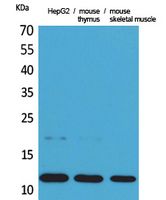Eotaxin Polyclonal Antibody
- Catalog No.:YT5444
- Applications:WB;ELISA
- Reactivity:Human;Mouse;Rat
- Target:
- Eotaxin
- Fields:
- >>Cytokine-cytokine receptor interaction;>>Viral protein interaction with cytokine and cytokine receptor;>>Chemokine signaling pathway;>>IL-17 signaling pathway;>>Asthma
- Gene Name:
- CCL11
- Protein Name:
- Eotaxin
- Human Gene Id:
- 6356
- Human Swiss Prot No:
- P51671
- Mouse Gene Id:
- 20292
- Mouse Swiss Prot No:
- P48298
- Rat Gene Id:
- 29397
- Rat Swiss Prot No:
- P97545
- Immunogen:
- The antiserum was produced against synthesized peptide derived from the Internal region of human CCL11. AA range:41-90
- Specificity:
- Eotaxin Polyclonal Antibody detects endogenous levels of Eotaxin protein.
- Formulation:
- Liquid in PBS containing 50% glycerol, 0.5% BSA and 0.02% sodium azide.
- Source:
- Polyclonal, Rabbit,IgG
- Dilution:
- WB 1:500 - 1:2000. ELISA: 1:20000. Not yet tested in other applications.
- Purification:
- The antibody was affinity-purified from rabbit antiserum by affinity-chromatography using epitope-specific immunogen.
- Concentration:
- 1 mg/ml
- Storage Stability:
- -15°C to -25°C/1 year(Do not lower than -25°C)
- Other Name:
- CCL11;SCYA11;Eotaxin;C-C motif chemokine 11;Eosinophil chemotactic protein;Small-inducible cytokine A11
- Observed Band(KD):
- 11kD
- Background:
- This antimicrobial gene is one of several chemokine genes clustered on the q-arm of chromosome 17. Chemokines form a superfamily of secreted proteins involved in immunoregulatory and inflammatory processes. The superfamily is divided into four subfamilies based on the arrangement of the N-terminal cysteine residues of the mature peptide. This chemokine, a member of the CC subfamily, displays chemotactic activity for eosinophils, but not mononuclear cells or neutrophils. This eosinophil-specific chemokine is thought to be involved in eosinophilic inflammatory diseases such as atopic dermatitis, allergic rhinitis, asthma and parasitic infections. [provided by RefSeq, Sep 2014],
- Function:
- function:In response to the presence of allergens, this protein directly promotes the accumulation of eosinophils, a prominent feature of allergic inflammatory reactions. Binds to CCR3.,induction:By TNF-alpha, interleukin-1 alpha and interferon gamma.,online information:CCL11 entry,PTM:O-linked glycan consists of a Gal-GalNAc disaccharide which is mofified with up to 2 sialic acid residues.,similarity:Belongs to the intercrine beta (chemokine CC) family.,
- Subcellular Location:
- Secreted .
- Expression:
- Blood,Foreskin,Lung,Placenta,Small intestine,
- June 19-2018
- WESTERN IMMUNOBLOTTING PROTOCOL
- June 19-2018
- IMMUNOHISTOCHEMISTRY-PARAFFIN PROTOCOL
- June 19-2018
- IMMUNOFLUORESCENCE PROTOCOL
- September 08-2020
- FLOW-CYTOMEYRT-PROTOCOL
- May 20-2022
- Cell-Based ELISA│解您多样本WB检测之困扰
- July 13-2018
- CELL-BASED-ELISA-PROTOCOL-FOR-ACETYL-PROTEIN
- July 13-2018
- CELL-BASED-ELISA-PROTOCOL-FOR-PHOSPHO-PROTEIN
- July 13-2018
- Antibody-FAQs
- Products Images

- Western Blot analysis of HepG2, mouse thymus, mouse skeletal muscle cells using Eotaxin Polyclonal Antibody. Secondary antibody(catalog#:RS0002) was diluted at 1:20000



